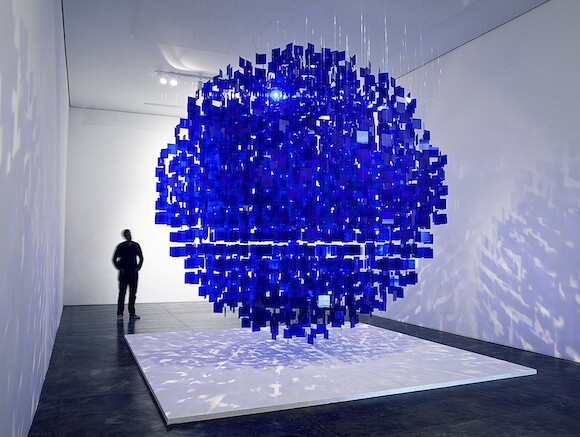Galeria Nara Roesler
Av. Europa, 655, São Paulo, SP
01449-001 Brazil
Celebrating a partnership of 15 years, Galeria Nara Roesler honors Julio Le Parc with a seminal show in São Paulo and a special focus on his historical oeuvre at Frieze Masters and FIAC.
Solo show:
A constant quest @ Galeria Nara Roesler São Paulo, Brazil
Featuring immersive installations, including the never before seen Sphère Bleue (2013), this major show presents historical paintings, maquettes, and color studies from the artist’s private collection.
Art Fairs:
Spotlight on Julio Le Parc @ Frieze Masters
Galeria Nara Roesler – Booth s23 London
A special booth created by Le Parc under the selection of Adriano Pedrosa, head curator of Frieze Spotlight section, the project highlights works belonging to the 1950s and ’60s, particularly from the series “Contorsions,” “Deplacements,” and “Lumière.”
Julio Le Parc and Lucia Koch @ FIAC
Galeria Nara Roesler – Booth 0.C51 Paris
At FIAC, Galeria Nara Roesler presents two newly commissioned works by Julio Le Parc and Lucia Koch. Each presenting large-scale immersive installations, the pieces create a dialogue of light and movement within the booth space.
Also, do not miss:
Le Parc Lumière @ Casa Daros Rio de Janeiro
A special focus on light alterations, Le Parc Lumière features key works from the Daros Latinamerica Collection dating from the 1960s.
About Julio Le Parc
Born in 1928 in Mendoza, Argentina, Julio Le Parc attended the Escuela de Bellas Artes in Buenos Aires in 1943. Le Parc rapidly became engaged with the flourishing avant-garde scene and with leftist activist groups. In reaction to the repressive dictatorship of Juan Perón, the artist dropped out of art school returning only after the dictator’s fall in 1955. Upon his return, Le Parc took a leadership role as an artist-advocate joining the university students’ organization Federación Universitaria Argentina, a major force of militant government opposition.
Victor Vasarely’s 1958 exhibition in Buenos Aries became an important catalyst for Le Parc’s departure for Paris that year. Awarded a scholarship to study in Paris, Le Parc pursued collaborative work with fellow artist friends of Vasarely and co-founded the Groupe de Recherche d’Art Visuel (GRAV) in 1960. While Le Parc’s early geometric paintings were first informed by the Constructivist tradition of Arte-Concreto Invención in Buenos Aires, works produced soon after his arrival in Paris also reflect a growing interest in the work of Mondrian and Vasarely. By early 1960, Le Parc began incorporating movement and light into his research. Interested in the possibilities of movement, and the participation of the viewer, he developed his signature kinetic sculptures and light environments, which would ultimately bring him international recognition as a leading exponent of Kinetic Art.
Representing Argentina at the 1966 Venice Biennale, Le Parc won the Grand International Prize for Painting as an individual artist. Although the group dissolved in 1968, Le Parc continued to work simultaneously as an individual artist and as part of international collectives, particularly those involved in politically denouncing totalitarian regimes. Le Parc’s participation in the May 1968 Paris uprising and union rallies led to his expulsion from France for a period of a year. Upon his return to Paris, Le Parc became an important conduit between activist Latin American artists and the Paris art scene, most specifically through the Paris publication ROBHO, for which he covered the events of the artist collaborative Tucumán Arde in Argentina.
Le Parc’s works have been the subject of numerous solo shows in Europe and Latin America, including Instituto di Tella (Buenos Aires), Museo de Arte Moderno (Caracas), Palacio de Bellas Artes (Mexico), Casa de las Americas (Havana), Moderna Museet (Stockholm), Daros (Zürich), Städtische Kunsthalle (Düsseldorf). Le Parc’s works have also been included in numerous group exhibitions and biennials, including the Museum of Modern Art’s controversial exhibition The Responsive Eye (1965), the Venice Biennale in 1966 (where he was awarded the Prize), and the São Paulo Biennial (1967). As acts of protest against repressive military regime in Brazil, Le Parc joined artists in boycotting the 1969 São Paulo Biennial and published an alternative Contrabienal catalogue in 1971. Le Parc’s later collective works included participation in anti-fascist movements in Chile, El Salvador and Nicaragua.
More recently Le Parc’s work has been the subject of a major 2013 retrospective, Soleil froid, at the Palais de Tokyo, and included in the group exhibition Dynamo at the Grand Palais in Paris.

